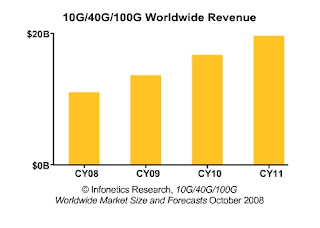 The 10 gigabit-per-second equipment market is big and growing fast, on target to hit nearly $9.5 billion worldwide in 2008, say researchers at Infonetics Research. At the same time, 40 G system sales are ramping rapidly, and 100 G should begin soon and take off by 2013, the company says.
The 10 gigabit-per-second equipment market is big and growing fast, on target to hit nearly $9.5 billion worldwide in 2008, say researchers at Infonetics Research. At the same time, 40 G system sales are ramping rapidly, and 100 G should begin soon and take off by 2013, the company says.“A majority of service providers we've spoken to are expecting to invest in 40 G until the 100 G market is up and running; some providers are hoping to skip the 40 G phase altogether, but we don't see that being a viable option, as growing traffic demands are outstripping current capacities and 100 G won't reach reasonable price points until about 2012 or 2013," says Michael Howard, Infonetics co-founder and principal analyst.
"When 100 G Ethernet arrives, it’ll be the next big thing and the most important, because it will last to at least 2025, solving traffic problems for a very long time," Howard says.
40G equipment revenue is forecast to increase at a fast clip, with a compound annual growth
rate of 59 percent from 2007 to 2011, Infonetics projects.
The number of 10 G, 40 G, and 100 G ports shipping on enterprise and service provider equipment will jump from over one million in 2007 to 7.4 million in 2011, with 100 G making its small debut in 2009.




